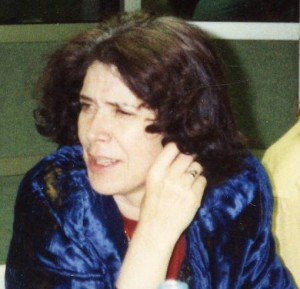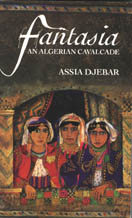Biography

Assia Djebar was born Fatima-Zohra Imalayen in Cherchell, Algeria on August 4, 1936. She published her first novel, La Soif, under pen name Assia Djebar in 1957, followed by her second novel, Les Impatients, in 1958. In that same year, Djebar married Walid Garn and worked toward advanced degree in history at University of Algiers.
In 1962, Djebar published her novel Les Enfants du Nouveau Monde, and Les Alouettes Naives followed in 1967. Rouge l’Aube, a play written in collaboration with husband Garn, was performed at the third Pan-African Cultural Festival held in Algiers in 1969. She published a volume of poetry, Poems pour l’Algerie heureuse, in 1969 as well.
Djebar was known for her cinematic work, and in 1977, she directed her first film, La Nouba des femmes du Mont Chenoua. In 1979, she directed her second film, La Zerda ou les chants de l’oubli, a documentary juxtaposing French newsreels of World War I and II and Algerian women singing traditional songs. She followed this up by publishing a short story collection, Femmes d’Alger dans leur appartement, in 1980, and soon after married Malek Alloula, another Algerian writer. They resided in Paris, where she was appointed to the Algerian Cultural Center in Paris.
In 1985, Djebar published the first novel of a projected quartet, L’Amour, la fantasia. The second volume, Ombre sultane, followed two years later.
In her later years, Djebar was the first writer from North Africa to be accepted into the Academie Francaise, and acted as a professor of Francophone literature at New York University. She won the Neustadt International Prize for Literature in 1996 and the Peace Prize of the German Book Trade in 2000. She died in February 2015.
Fantasia, an Algerian Cavalcade: Expressing “Third World” Feminist Issues
Revising Colonial Constructions of History
Subjectivity and the Subaltern
The intellectual movements of the 20th Century, including Derridean deconstruction and Lacanian psychoanalytic theory, have continued the move away from the 18th and 19th century notions of the universal subject, contesting the unified “I” and replacing it with fractured, multiple subject positions. Feminist theorists like Luce Irigaray, Helene Cixous, Gayatri Spivak and others are interested in theorizing female subjectivity in all its diversity and multiplicity in answer to phallocentric constructions that continue to figure subjectivity as masculine and female consciousness as lack. In “Can the Subaltern Speak?”, Spivak summarizes her project of constructing a new model of female subjectivity, a gesture Djebar takes up in L’Amour, la fantasia: “My readings are, rather, an interested and inexpert examination, by a postcolonial woman, of the fabric of repression, a constructed counter-narrative of woman’s consciousness, thus woman’s being, thus woman’s being good, thus the good woman’s desire, thus woman’s desire” (299). Djebar joins her own voice and life story with the stories and voices of Algerian women revolutionaries, replacing silence and the colonizer’s version of history with a celebration of female experience and expression. Speaking neither for nor to her subaltern sisters, Djebar speaks with them, emphasizing the collective nature of female expression. Djebar realizes the ways in which her own story is intimately linked to the forgotten and silenced testimonies of other women: “Can I, twenty years later, claim to revive these stifled voices? And speak for them? Shall I not at best find dried-up streams? What ghosts will be conjured up when in this absence of expressions of love (love received, ‘love’ imposed), I see the reflection of my own barrenness, my own aphasia” (Djebar 202). In telling their stories, Djebar and the women revolutionaries reclaim not only their individual and collective voices, but their bodies as well.
Speaking the self is linked in important ways to speaking the experience of female embodiment. Sidonie Smith articulates the intersection of subjectivity and body that occurs in autobiographical projects: “When a specific woman approaches the scene of writing and the autobiographical ‘I,’ she not only engages the discourses of subjectivity through which the universal human subject has been culturally secured; she also engages the complexities of her cultural assignment to an absorbing embodiment. And so the autobiographical subject carries a history of the body with her as she negotiates the autobiographical ‘I,’ for autobiographical practice is one of those cultural occasions when the history of the body intersects the deployment of subjectivity” (22-23). Djebar’s treatment of the veil, her own escape from cloistering, and her subsequent access to academia and writing suggests that the female body is a locus of potential power, rebellion, and knowledge that threatens the status quo of male privilege: “The fourth language, for all females, young or old, cloistered or half-emancipated, remains that of the body: The body which male neighbors’ and cousins’ eyes require to be deaf and blind, since they cannot completely incarcerate it, the body which, in trances, dances, or vociferations, in fits of hope and despair, rebels, and unable to read or write, seeks some unknown shore as destination for its message of love” (Djebar 180). The image of the dismemebered hand at the novel’s conclusion suggests the connection between body and voice, subjectivity and embodied experience: “Later, I seize this living hand, hand of mutilation and of memory, and I attempt to bring it the qalam” (Djebar 226).
Feminist Challenges to Discourses of Nationalism
The story of Djebar and the women freedom fighters is also the story of Algeria and the journey from colonization and subjugation to independent nation. Djebar’s text refigures nationalist strategies by replacing history written by the colonizer with a history of heroic women. The re-writing of history is a common step in the project of nationalism, but most often the revised history of a colonized nation continues to be a male-centered history (see Gender and Nation). By moving women from the margin to the forefront of her recreated history, Djebar documents women’s historic roles as revolutionaries and makes the case that they deserve status as full citizens in the new nation they have helped to build. Danielle Marx-Scouras draws connections between Djebar’s themes of subjectivity, body, voice and nationalism as they relate to Djebar’s feminist political agenda: “The amputated hand symbolizes Algeria, mutilated by a history written by the hands of others (French historians, writers, artists) but, perhaps more importantly for Djebar, it also represents Algerian women amputated in their desire to write or express themselves. The dominant images of the novel – abduction and rape – sexualize the representation of Algeria, which becomes, in the final analysis, the female body. If it is on this body that the history of the French conquerors has been written, it is from this body that the decolonization of a people must be written – be they men or women” (176). The nation that women have helped to make independent has a duty to recognize the issues and concerns of women’s oppressions. Djebar’s project seeks to “resurrect so many vanished sisters” (204), to restore them to their rightful place within the new nation, to have their voices speak and be heard as full participants in the project of decolonization and nation-building.
Selected Bibliography
- Djebar, Assia. Vaste est la prison: roman. Paris: Albin Michel, 1995.
- —. Far from Madina. London: Quartet, 1994. (originally published in French as Loin de Medine. Paris: Albin Michel, 1991)
- —. A Sister to Scheherazade. Dorothy S. Blair, trans. London: Quartet, 1987. (originally published in French as L’Ombre sultane. Paris: Jean-Claude Lattes, 1987.)
- —. Fantasia, an Algerian Cavalcade. Dorothy S. Blair, trans. London: Quartet, 1985. (originally published in French as L’Amour, la fantasia. Paris: Jean-Claude Lattes, 1985.)
- —. Women of Algiers in Their Apartment. Marjolijn de Jager, trans. Charlottesville: University Press of Virginia, 1992. (originally published in French as Femmes d’Alger dans leur appartement. Paris: Edition des Femmes, 1980.)
- —. La Zerda ou les chants de l’oubli. 1982.
- —. La Nouba des femmes du Mont Chenoua. 1979.
- —. Les Alouettes naives. Paris: Julliard, 1967.
- —. Rouge l’aube. Alger: S.N.E.D., 1969.
- —. Poems pour l’Algerie heureuse. Alger: S.N.E.D., 1969.
- —. Les Enfants du Nouveau Monde. Paris: Julliard, 1962.
- —. Les Impatients. Paris: Julliard, 1958.
- —. La Soif. Paris: Julliard, 1957.
- Donadey, Anne. “Assia Djebar’s Poetics of Subversion.” L’Esprit Creatur 33:2 (Summer 1993): 107-17.
- Green, Mary Jean. “Dismantling the Colonizing Text: Anne Hebert’s Kamouraska and Assia Djebar’s L’Amour, la fantasia.” The French Review 66:6 (May 1993): 959-66.
- Ghaussy, Soheila. “A Stepmother Tongue: ‘Feminine Writing’ in Assia Djebar’s Fantasia: An Algerian Calvalcade.” World Literature Today 68:3 (Summer 1994): 457-62.
- Goodman, Joanna. “L’Ecrit et le cri: Giving Voice in Assia Djebar’s L’Amour, la fantasia.” Edebiyat 6:1 (1995): 1-19.
- Marx-Scouras, Danielle. “Muffled Screams/Stifled Voices.” Yale French Studies 82 (1993): 172-82.
- Mortimer, Mildred. Assia Djebar. Philadelphia: Celfan Ed. Monogs., 1988.
- —. “Language and Space in the Fiction of Assia Djebar and Leila Sebbar.” Research in African Literatures 19:3 (Fall 1988): 301-11.
- — . “The Evolution of Assia Djebar’s Feminist Conscience.” Contemporary African Literature. Hal Wylie et al, eds. Washington, D.C.: Three Continents & African Lit. Assn., 1983.
- Murdoch, H. Adlai. “Rewriting Writing: Identity, Exile and Renewal in Assia Djebar’s L’Amour, la fantasia.” Yale French Studies 83 (1993): 71-93.
- Page, Andrea. “Rape or Obscence Copulation? Ambivilance and Complicity in Djebar’s L’Amour, la fantasia.” Women in French Studies 2 (Fall 1994): 42-54.
- Smith, Sidonie. Subjectivity, Identity, and the Body: Women’s Autobiographical Practices in the Twentieth Century. Bloomington: Indiana University Press, 1993.
- Spivak, Gayatri Chakravorty. “Can the Subaltern Speak?” In Other Worlds: Essays in Cultural Politics. Gayatri Chakravorty Spivak, ed. New York: Routledge, 1987.
- Zimra, Clarisse. “Writing Women: The Novels of Assia Djebar.” SubStance 21:3 (1992): 68-84.
Author: Jennifer Bernhardt, Fall 1996
Last edited: May 2017

1 Comment
I need please the techniques used by asia djabar in fantasia